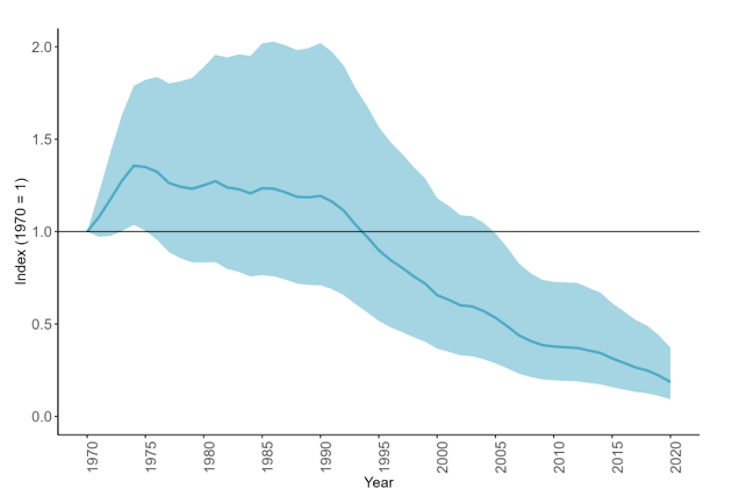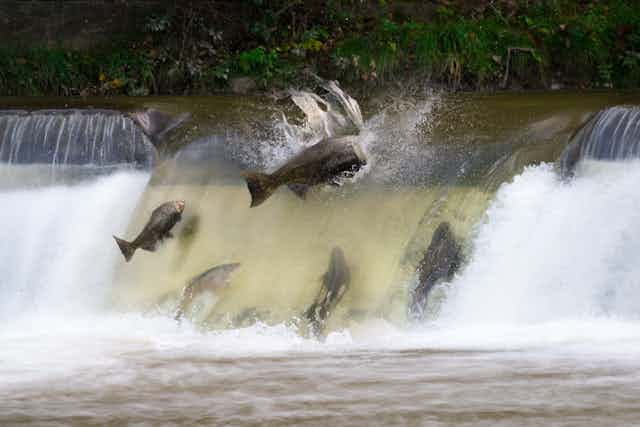Around the world, free-flowing natural rivers are being fragmented by dams, weirs and other barriers. It’s one of the biggest, yet least acknowledged, causes of biodiversity loss worldwide.
River fragmentation is a key reason migratory fish populations have declined by 81% since 1970, according to a new report by the Living Planet Index – a rate of wildlife loss six times that of animals that live on land or in the sea.
These migratory fish need to move between different parts of rivers, estuaries and oceans at different stages in their lives. For instance salmon go from the sea to rivers or lakes to reproduce, while eels do the opposite.
Some species migrate within large river systems, like the Clanwilliam sandfish which moves from lowland rivers into small headwaters of South Africa’s Cederberg Mountains to spawn. The dorado or Goliath catfish migrates more than 11,000 km from spawning habitats in the high Andes to nursery areas in the Amazon River mouth.
An 80% decline in five decades:

That’s why it’s crucial to maintain as many free-flowing rivers as possible to allow species and nutrients to pass from upstream headwaters to the floodplains, deltas and estuaries downstream. Yet growing demand for renewable energy means there are at least 3,500 hydropower dams under different stages of development around the world, which, when complete, will nearly double the number of large dams on Earth.
There are already over a million river barriers in Europe alone, and at least 16 million worldwide. Only around a third of the world’s longest rivers remain free flowing and less than a quarter flow uninterrupted into the open ocean. Once the new hydroelectric dams are all completed, 93% of the rivers on Earth are expected to be classified as moderately to severely fragmented.
Unintended consequences
With barriers now blocking their natural routes, no wonder there has been a catastrophic decrease in these migratory freshwater fish. According to the new report, the most alarming losses are in Latin America and the Caribbean, where populations are less than a tenth of what they were in 1970.
This region has a high reliance on hydropower electricity and is threatened by increasing drought risk, but millions of people directly rely on these fish for food, livelihoods and traditional culture. The global thirst for renewable, “clean” electricity might therefore lead to unintended consequences.
While a single dam can cause serious disruptions, barriers act in tandem with other major stressors to cause even more devastating effects. Barriers increase water temperatures, compounding trends driven by climate warming. Warmer water holds less oxygen and puts fish under stress. And then those same barriers make it harder for fish to leave uninhabitable areas for cooler water upstream.
Species which are adapted to fast-flowing, highly oxygenated cool water are overwhelmingly adversely affected and rapidly disappear from rivers impacted by barriers. Dams also trap sediments, which then alters habitats used by fish, as well as making it easier for non-native invasive species to establish.
Down with dams
One river in the US is showing a possible way forward. In an unprecedented operation to rectify the ecological damage caused by damming, six dams along 400 miles of the Klamath River in Oregon are being removed.
The Klamath River will run free, with sections having water flow after being dry for almost 100 years. Migratory salmon and steelhead trout will once again swim freely throughout the river basin, Indigenous communities will have access to traditional fisheries, and water quality will be restored.
There are options short of full dam-removal. In many parts of the world, dam operations are also being modified in attempts to make the water flow more naturally.
It may be possible to remediate some of the catastrophic impact river fragmentation has had on migratory fish species. However, this will depend on major and urgent engineering interventions, that effectively balance the need for water storage in reservoirs with human needs for freshwater biodiversity.

